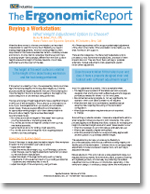Wrists at Risk: Awkward Postures to Avoid
By Joy M. Ebben, Ph.D, CPE
Human Factors and Ergonomic Specialist, IAC, a Divsion of Treston, Brea, Calif.
Ouch! On-the-job repetitive stress injuries (RSIs) are debilitating to workers, and costly for their employers as well. According to a survey conducted by the newsletter CTD News RSIs cost U.S. businesses about $10.8 billion last year! That bottom-line debit drives industry’s interest in ergonomics.
RSIs afflict people who perform repetitive tasks such as typing on a keyboard and working on an assembly line. Very often, they do so using awkward postures and stressful motions. I see a lot of it in the “light-duty” electronics manufacturing workplace.
The good news is that a properly designed workstation can help minimized the risk of musculoskeletal disorders affecting tendons, muscles and nerves. Appropriate working height and welldesigned workstation accessories, for example, are valuable aids in counteracting the often hurtful consequences of repetitive tasks.
To employ these ergonomic advantages to best effect, however, we have to first understand what undesirable stressful and awkward postures look like, and what their likely causes are. Only then can we begin to advise customers on which IAC workstation accessories are good choices for their applications.
Carpal tunnel syndrome, an irritation of the nerves in the wrist, was the costliest form of RSI in CTD News’ survey—an average $4, 764 per case in direct costs for insurance claims and premiums. Let’s examine stressful postures involving the wrist, and some workstation related issues.
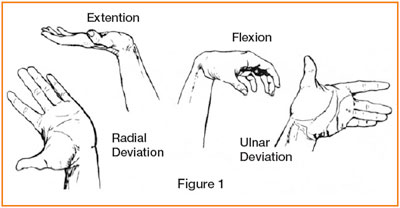 Figure 1 illustrates four bent wrist postures that are known to be stressful: flex (bending toward the palm,) extension (bending up and back,) radial deviation (toward the thumb,) and ulnar deviation (toward the little finger.) Bending is quantified as the angle between wrist and forearm. Zero degrees is neutral. Any of these awkward wrist postures can lead to muscle, tendon, and nerve disorders, especially if combined with high repetition and forceful exertion.
Figure 1 illustrates four bent wrist postures that are known to be stressful: flex (bending toward the palm,) extension (bending up and back,) radial deviation (toward the thumb,) and ulnar deviation (toward the little finger.) Bending is quantified as the angle between wrist and forearm. Zero degrees is neutral. Any of these awkward wrist postures can lead to muscle, tendon, and nerve disorders, especially if combined with high repetition and forceful exertion.
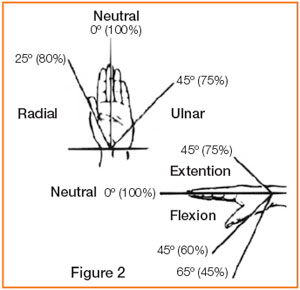 Figure 2 depicts grip strength at various wrist angles (expressed as a percentage of power grip measured at 100% in a neutral position.) Note that as the angle increases or decreases from neutral, there is a proportional decrease in effective strength. You can experience the differences in strength by bending your wrist in various directions while gripping an object.
Figure 2 depicts grip strength at various wrist angles (expressed as a percentage of power grip measured at 100% in a neutral position.) Note that as the angle increases or decreases from neutral, there is a proportional decrease in effective strength. You can experience the differences in strength by bending your wrist in various directions while gripping an object.
There are no consistent guidelines for establishing wrist bending limits. This is due, in part, to differences between people and tasks (how much repetition and exertion is required.) In general, bad wrist postures are often the result of poor tool design, poor access to the components, nuts, bolts, etc. needed for the item being assembled, and the assembly process itself. Other influences are the design of hand tools workers are using, their personal working “technique”, and the height of data entry devices (i.e., are wrist rests needed?)
In configuring a workstation, I often suggest angled parts cups, tilt-angled shelves, and tilting work surfaces, if one of my goals is to lessen the stress of awkward wrist postures.
 Buy Online Now!
Buy Online Now!
 Buy Online Now!
Buy Online Now!


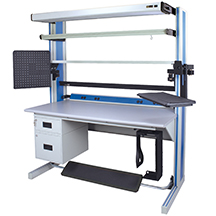
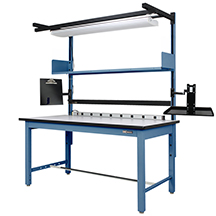
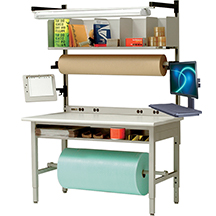
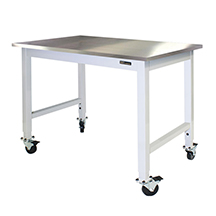





 Figure 1 illustrates four bent wrist postures that are known to be stressful: flex (bending toward the palm,) extension (bending up and back,) radial deviation (toward the thumb,) and ulnar deviation (toward the little finger.) Bending is quantified as the angle between wrist and forearm. Zero degrees is neutral. Any of these awkward wrist postures can lead to muscle, tendon, and nerve disorders, especially if combined with high repetition and forceful exertion.
Figure 1 illustrates four bent wrist postures that are known to be stressful: flex (bending toward the palm,) extension (bending up and back,) radial deviation (toward the thumb,) and ulnar deviation (toward the little finger.) Bending is quantified as the angle between wrist and forearm. Zero degrees is neutral. Any of these awkward wrist postures can lead to muscle, tendon, and nerve disorders, especially if combined with high repetition and forceful exertion. Figure 2 depicts grip strength at various wrist angles (expressed as a percentage of power grip measured at 100% in a neutral position.) Note that as the angle increases or decreases from neutral, there is a proportional decrease in effective strength. You can experience the differences in strength by bending your wrist in various directions while gripping an object.
Figure 2 depicts grip strength at various wrist angles (expressed as a percentage of power grip measured at 100% in a neutral position.) Note that as the angle increases or decreases from neutral, there is a proportional decrease in effective strength. You can experience the differences in strength by bending your wrist in various directions while gripping an object.